UTAH WOMEN’S HISTORY / Utah Women’s Suffrage: Reader’s Theater and Voting Simulation
Utah Women’s Suffrage: Reader’s Theater and Voting Simulation
Lesson Overview
This lesson provides students with information about the main events and key players involved in Utah women’s suffrage over the course of several key periods: 1) enfranchisement (1860s-1870), 2) disfranchisement (1871-1887), 3) re-enfranchisement with statehood (1888-1896), and 4) the ratification of the 19th Amendment (1920). Students will participate in a reader’s theater and a voting simulation requiring them to view and write about these historical events through various perspectives.
This lesson is also available on Canvas Commons.
Recommended Instructional Time: 60-90 minutes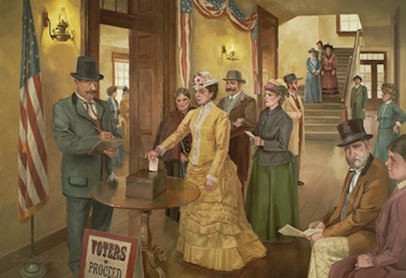
Historical Background for Educators
Utah was at the forefront of the women’s suffrage movement. Though Wyoming Territory was first to extend voting rights to women citizens (in December 1869), Utah Territory passed a similar law several weeks later, in February 1870. Since Utah held its next elections before Wyoming did, Utah women became the first to cast votes.
“I openly declare myself a woman’s rights woman!” –Sarah M. Kimball
At that time, members of the Utah-based Church of Jesus Christ of Latter-day Saints practiced polygamy, a form of marriage in which a husband could have more than one living wife. Mormons called it “plural marriage” and considered it a religious belief. People against polygamy considered it morally wrong and oppressive to women. Anti-polygamists hoped Utah women would vote for candidates who wanted to end polygamy. When Mormon women instead voted to support polygamy, anti-polygamists lobbied Congress to pass anti-polygamy laws. In 1887, Congress passed the Edmunds-Tucker Act, which took away the voting rights of all Utah women, regardless of their marital or religious status.
After exercising the privilege of voting for seventeen years, many Utah women felt outraged when Congress took those rights away. They worked hard to win them back, working with national suffrage leaders and organizing suffrage associations throughout Utah.
In 1890, the LDS Church announced the end of plural marriage in Utah. With this official change in church policy, Congress invited Utah Territory to apply again for statehood. (Utah had applied to enter the Union as a state several times before over the previous four decades, but Congress denied each application, partly because of the widespread practice of polygamy in the territory).
“All men and women are created free and equal.” –Dr. Martha Hughes Cannon
During Utah’s 1895 Constitutional Convention, delegates debated whether to include women’s suffrage in the constitution that Utah would propose to Congress. Suffragists from throughout the territory lobbied delegates to include equal suffrage in the constitution. Despite minor opposition, the delegates voted to include a clause that guaranteed a woman’s right to vote and hold public office. Utahns then voted overwhelmingly to approve the proposed constitution. Utah women regained the vote, or were re-enfranchised, in 1896, after Congress accepted Utah’s constitution and application and President Grover Cleveland approved.
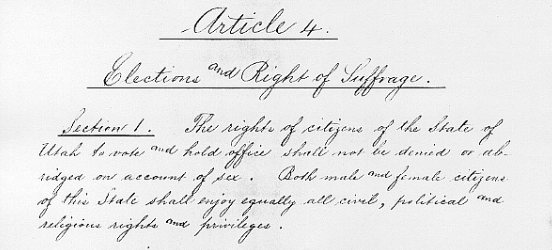
Article 4, Section 1 from the Utah State Constitution, Elections and Right of Suffrage.
It is important to note that not all women residing in Utah could vote in 1870 or with statehood in 1896 or with the ratification of the 19th Amendment in 1920. Utah women who were granted voting rights in 1870 only included “every woman of the age of twenty-one years who has resided in this Territory six months next preceding any general or special election, born or naturalized in the United States, or who is the wife, widow or the daughter of a native-born or naturalized citizen of the United States.” And in 1895, the Utah State Constitution stated: “The rights of citizens of the State of Utah to vote and hold office shall not be denied on account of sex.” Thus, only those who were considered citizens were allowed to vote.
So, for example, since Native Americans were not considered U.S. citizens during this time period, they were excluded from women’s voting rights in Utah in 1870 and 1896, and nationally in 1920. American Indians gained voting rights when Congress granted them U.S. citizenship through the Indian Citizenship Act in 1924 (can you see the irony?). Many states, including Utah, nonetheless made laws and policies which prohibited American Indians from voting, claiming that American Indians living on reservations were residents of their own nations and thus non-residents of the states. On February 14, 1957, the Utah state legislature repealed its legislation that had prevented American Indians living on reservations from voting, becoming one of the last states to do so.
Key Utah State Standards
Language Arts
- Reading: Informational Text Standard 3: Explain events, procedures, ideas, or concepts in a historical, scientific, or technical text, including what happened and why, based on specific information in the text.
- Reading: Foundational Skills Standard 4: Read with sufficient accuracy and fluency to support comprehension.
Social Studies
- Standard 3: Students will understand the roles of civic life, politics, and government in the lives of Utah citizens.
- Objective 1c: Determine how and why the rights and responsibilities of various groups have varied over time (e.g. women, Mormons, American Indians, African-Americans).
Learning Objectives
- Students will be able to explain how and why the voting rights of Utah women changed over time by performing a reader’s theater, participating in a voting simulation activity, and writing from the perspective of a historical person.
Guiding Questions
- Why was Utah a forerunner in granting voting rights to women?
- Why were Utah women’s voting rights taken away by Congress?
- How were Utah women involved politically and civically at local and national levels?
- How and why are rights given, taken away, and/or withheld from various groups?
Vocabulary
(noun) a ticket or piece of paper used to vote
Seraph Young was the first woman in the modern United States to cast a ballot in an election.
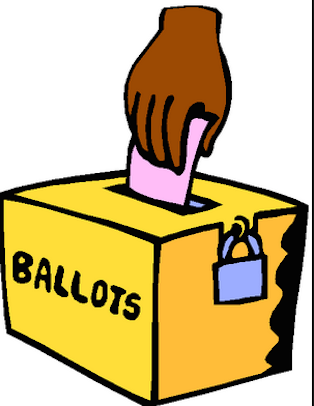
(verb) to make official by voting for and signing (a constitutional amendment)
In August 1920, the 19th Amendment granting women’s voting rights was ratified by three-fourths of the states.
(noun) To take away someone’s right to vote
The Edmunds-Tucker Act caused the disfranchisement of Utah women.
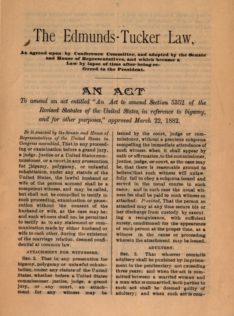
(noun) To give someone the right to vote
Emmeline B. Wells was a Utah leader involved in the enfranchisement of women.
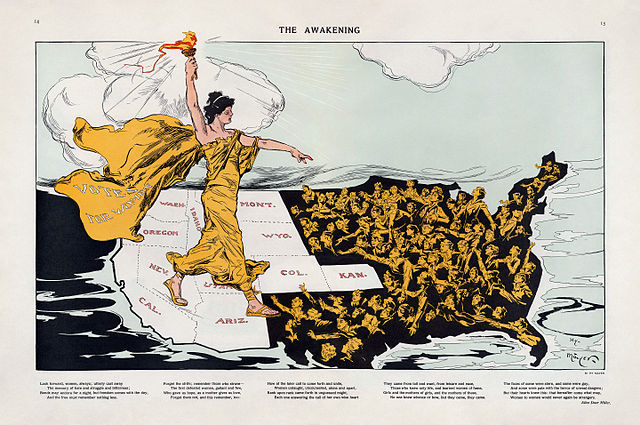
(n) the right to vote
The 19th Amendment granted the franchise to women.
(v) to give the right to vote
The 19th Amendment franchised women.
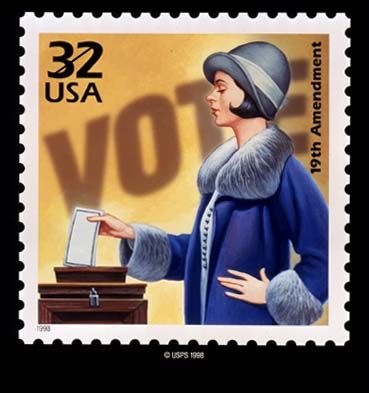
(noun) A marriage system in which a person is married to more than one person at a time.
The Church of Jesus Christ of Latter-day Saints practiced polygamy, in which some husbands had more than one living wife.
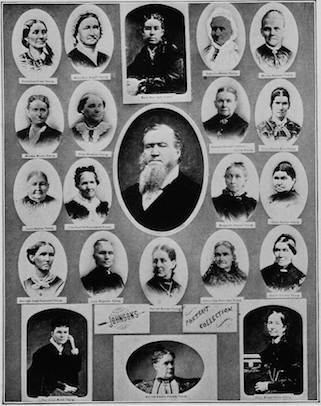
(noun) The right to vote in a political election
During the women’s suffrage movement, women fought for and won the right to vote in political elections.
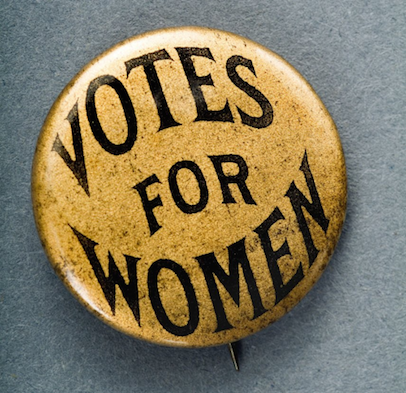
(noun)
to give back someone’s right to vote
“Re” = to do again
The re-enfranchisement of Utah women occurred when Utah attained statehood.
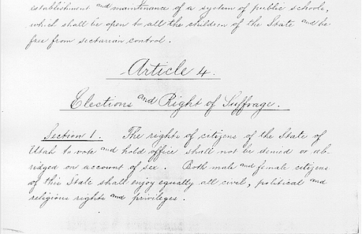
(noun) an organization that is a chapter (or part of) of a larger organization
Utah had affiliates, or chapters, of the larger National American Women’s Suffrage Association throughout the state.
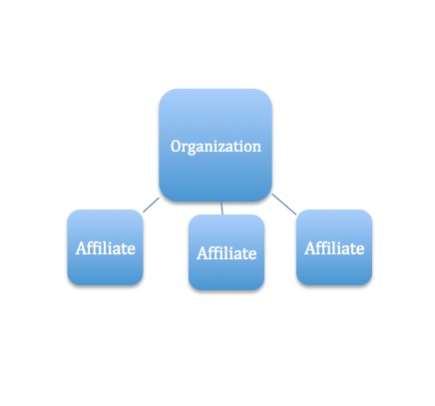
(verb): to try to influence government officials to make decisions for or against something.
Anti-polygamists lobbied Congress to make polygamy illegal.
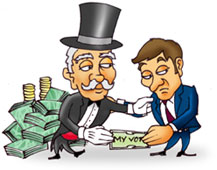
(verb) to give up doing something
In 1890, the LDS Church disavowed, or ended, the practice of polygamy.
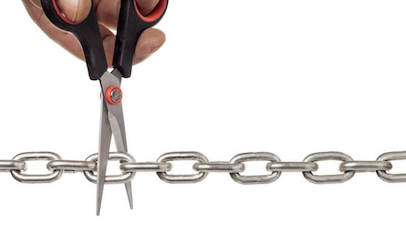
Materials Needed
Lesson
Activating and Building Background Knowledge
- Present the following scenario to students: You’re having a conversation with your family about what to eat for dinner tonight. Everyone has a different opinion. Eventually after lots of discussion, someone says, “Let’s vote!” You think this is a great idea. However, you learn that the adults have decided that anyone under the age of 12 is not allowed to vote.
- Have students respond to the following reflection questions in writing on the “Warm-up Sheet.” Then, have them discuss their responses with a partner.
- Do you think this rule is fair?
- Why might the adults make this rule?
- How does this rule affect the voting results?
- How might you persuade the adults to allow you to vote? What reasons would you give?
- Tie this discussion into the following: “Today we’re going to learn more about the people who were involved in the fight for women’s voting rights, or suffrage, in Utah. We will consider their opinions and feelings on receiving, losing, and winning back their voting rights. This story is important because it shows how people worked together and with national leaders to ensure that they not only had these rights, but that these rights were protected by state and national laws. The fight for national women’s suffrage took 80 years, the longest fight for rights in our nation’s history. And even still, there were women and men who were unable to vote due to other laws and restrictions.”
- Review vocabulary. You may want to use the “key vocabulary” sheet with your students as a way to review key words used in the reader’s theater.
Reader’s Theater and Voting Simulations
- If you have not assigned roles ahead of time, assign reader’s theater roles to students.
- The Teacher’s Guide for the Reader’s Theater and Voting Simulation Activities provides a cast of characters, script, and directions for the voting simulation activities. The student script does not provide instructions for the voting simulation activities, but it does provide cues for when students need to pause to allow for these simulations to take place.
- At the end of the reader’s theater, students will participate in a quick write. Students may share their quick write responses with a partner or the whole class.
- You may choose to also show the short video (2:51) about this history as a follow-up.
Assessment
- After discussing the Quick Write, students will write a short summary using the “Summary Writing Sheet” about major Utah suffrage events.
- Have students select an event from Utah’s suffrage story (this event may have been highlighted in the reader’s theater or it could be on the website’s historical timeline) and write a journal entry using the “Journal Sheet” about this event from the point of view of their assigned historical person or another person from the cast list. For example, a student who performed Martha Hughes Cannon’s part (or who selects her from the cast list) might write about her state senate election win from her perspective. Or a student who selects Emmeline B. Wells might write about losing the vote due to the Edmunds-Tucker Act. Depending on time and your students, you may decide to have students partner together to complete this task.
- Students then research about their historical person by using the biographies on the Better Days 2020 website, wikipedia pages, or Suffrage Squad trading cards (coming soon). Students can also utilize the historical timeline to gather additional facts and details about their selected suffrage event.
- Students should include in the journal entry facts about their historical person and event and their ideas of the person’s possible feelings and opinions. The number of required facts can be determined by the teacher.
Adaptations
- If students are uncomfortable reading aloud, they could read the script silently or with a partner.
- Provide students with time to practice their parts before the reader’s theater performance.
- Assign students who need additional support to the chorus (all students) roles. Or allow them to select the role of their choice.
- Some students may be more comfortable drawing a comic strip or cartoon illustrating historical events and individuals’ perspectives than writing a journal entry.
Extensions
- Have students write journal entries about multiple suffrage events, particularly from the perspective of individuals who were involved for decades in the fight for suffrage–or who did not gain voting rights in 1870, 1896, or 1920 (i.e. Native Americans, African Americans).
- Have students partner with a student who chose a different historical person and write a dialogue between these two individuals about a Utah suffrage event or events. This extension would be especially interesting if the dialogue is written between two historical people who held opposing viewpoints on suffrage.
- Have students share why the story of Utah’s women’s suffrage has meaning and importance to them today. Does it matter to them that Utah was a leader in the suffrage movement? If so, why or why not?
- Women in Utah were civically-minded and engaged: voting in elections, running for political office, petitioning for causes, leading various political organizations. How does this involvement in the past compare to involvement by Utah women today? For more info, read here.
- Learn more about groups who did not have voting rights with the passage of the Utah state constitution, the 19th Amendment and/or who were barred from voting due to voter suppression laws and practices. What might those who were involved in fighting for these rights say to those who fought for women’s voting rights in Utah?
Tell us your experience
We’d love to hear about your experience in using this lesson to engage with your students so that we can better serve those who choose to use this lesson in the future.
Share Your Experience
